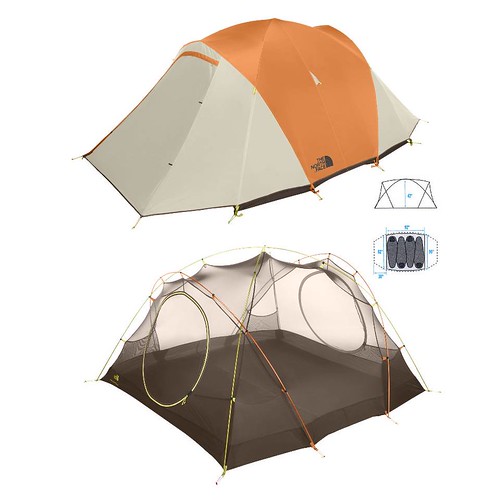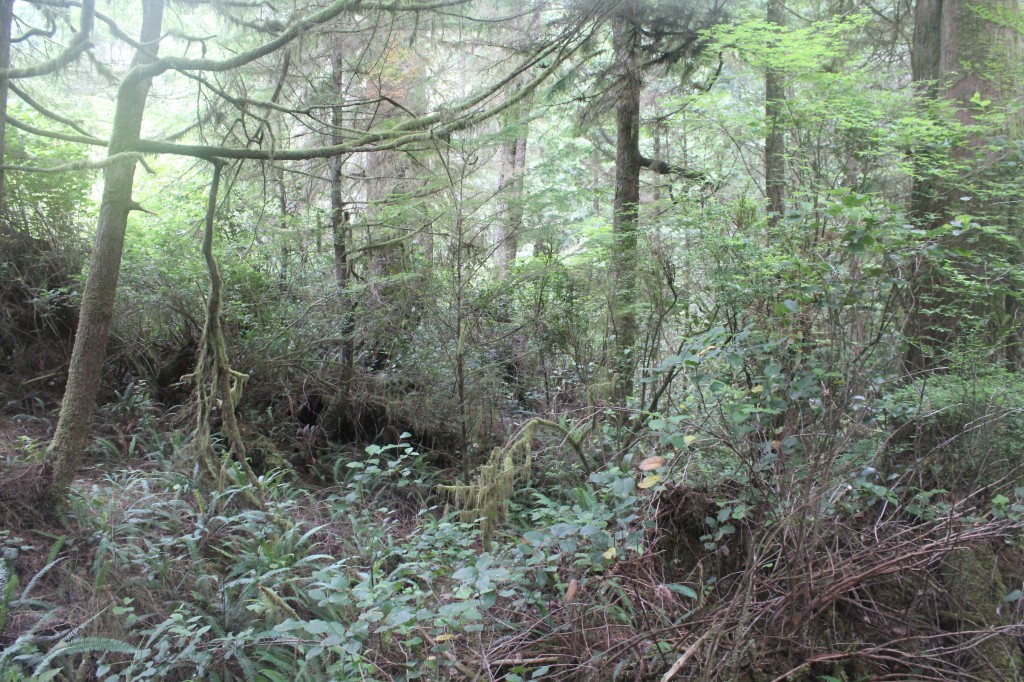Vital Statistics:
Gear Type – Tent
Person – 4
Season – 3
Trail Weight – About 8 lb
Floor – 54 square ft
Vestibule – 31 square ft
Additional Specs – The North Face
We purchased our Double Headed Toad 44 (now known simply as The Toad) from Camper’s Village in June of 2010. In addition to the tent itself, I also picked up a footprint, in the hopes of saving wear and tear on the floor of our tent.
The toad tent canopy is made of 70D 190T nylon ripstop, the floor is 70D 190T nylon taffeta with 5000 mm PU coating, and the fly is 70D 190T nylon ripstop with 1500 mm PU coating. It assembles with four DAC Press-Fit™ poles, which add terrific stability, without a lot of weight. I really like that you can assemble the fly independently of the tent, using the poles (and the footprint if you wish) for an extra-light shelter. The fly, tent, and even the footprint are color-coded, to coordinate with each other and the poles, which makes setting it up a breeze. A trained monkey could do it.
The tent canopy attaches to the poles via quick and easy clips, rather than sleeves. It includes six interior pockets for headlamps, phones, watches, etc. There are also a number of loops from which to hang small lanterns, or a compatible gear loft. The toad has a circular door at each end (affectionately referred to as “hobbit holes”) which opens into a small vestibule. The fly pegs down in 12 spots along its base (eight of those also anchor the tent and the footprint) with two additional anchor points for guy-lines, one on each side. The bright yellow guy-lines are included, although not attached to the tent itself.
Since purchasing, we have set up and taken down this tent around a dozen times, and it’s still in perfect condition. It’s been from the backcountry of Banff to Bon Echo Provincial Park in Ontario, and at least half a dozen sites between. We’ve used it in sunshine, rain, hail, and light snow, from temperatures ranging between 36°C and -10°C. Elevations have ranged from sea level to 2096 ft.
This is the first all-mesh tent canopy I’ve ever owned, and when properly staked out, I was pleased to find that there was plenty of room between the tent wall and the inside of the fly. This feature is particularly nice because it prevents moisture from transferring onto yourself or your gear if you accidentally rub up against the tent walls. The fly pegs down right to the ground, which keeps out wind and precipitation, but keeps in a surprising amount of warmth. When properly staked out, any condensation that collects inside of the fly, runs off appropriately, rather than dripping into the tent itself.
Even in moderate to heavier rain, for multiple days in a row, the fly did an exemplary job of keeping out moisture. The floor of the tent also proved impervious, even when there was a puddle between it and the footprint. Condensation is rather typical in volume, although as mentioned above, does not present any issues for tent occupants, provided the fly is staked down taut. The guy-lines are not required for this, however, I do recommend using them if you are setting up the tent in high winds. You will have to purchase additional pegs however, as the tent only includes the exact number required to peg down the tent and fly for normal use (I would encourage you to pick up and take a couple of extra pegs anyway, in case you lose or ruin one).
The vestibules, while rather small, did provide enough room to house my 90L pack, and Mike’s 116L pack, one in each end, with some room to spare. It can be a bit of a job climbing out in the morning without getting condensation all over yourself, but it you’re in no particular hurry, you can manage it with minimal effort.
While the toad is designed to house four people, we’ve only ever used it for two, because we like having extra room for gear. We were particularly grateful for the extra room during our trip to backcountry Banff, during which we got plenty of rain, and needed to keep most of our things inside and away from the moisture. It’s a bit heavy for two people to carry when backpacking, but if you’re only hiking in a day and then staying in one spot for several days, it’s worth the extra pounds in my opinion.
This tent isn’t short on space, that’s for certain. Mike is around 6’4 and he has plenty of room to stretch out in it. There is enough head room for sitting up, playing cards, or looking over the trail map. Four people could wait out a rain storm in relative comfort without having to perch on top of each other. I wouldn’t recommend sleeping more than three in it, however, as I personally don’t like being cramped.
Care and cleaning of this tent are as simple as setting it up and taking it down. On a sunny day, most of the condensation is generally burned off by the heat. If you need to dry it very quickly, I simply detach the fly, turn it inside out, and then stretch it back over the tent. This seems particularly effective. The tent body is very light, and with the poles still attached, you can tip it over on it’s side, exposing the bottom to the sunshine, which will dry it in no time. However, I’ve packed it up soaking wet more than once, and simply draped it to dry overnight in my basement or garage when I got home, until the next warm day, when I set it up in the yard and clean it thoroughly between uses. The footprint, which generally gets the dirtiest, is easily rinsed in the bathtub or shower (plain water, no soap) and then hung to dry over the shower curtain rod or in the garage. I would recommend washing the fly in the same way, but only if necessary. I usually just wipe any dirt from it with a damp cloth while I have it set up for cleaning. A damp cloth also works for the tent floor. Don’t forget to scrub any leftover dirt from your tent pegs as well, and allow to dry thoroughly before storing.
I love this tent, more than any other tent I’ve ever owned (and I think this is my fourth one) and I look forward to using it for many years to come. That said, Mike and I are currently shopping around for a 2-3 person backpacking tent, simply to save on weight, and because the toad is a bit large for the two of us when we are in the backcountry. The toad will remain my go-to tent for car camping, and for backpacking trips that include a third person sharing our sleeping quarters.
– Cal


Comments